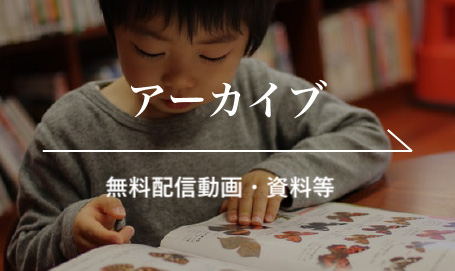< VOLUME 42, No.2 >
Kawahara Noriko. Toddlers’ Refusal Behaviors and Caregivers’ Intervention at Lunchtime : An Analysis of Interaction Patterns.
Research on Early Childhood Care and Education in Japan, 2004, 42(2), 112-120.
The aim of this research is to examine interaction between toddlers and caregivers focusing on toddlers’ refusal behaviors and caregivers’ intervention in that behavior. The behaviors of toddlers aged 12-24 months and their caregivers were videotaped. The result revealed four interaction patterns: 1) simple refusal, 2) persistence in refusal, 3) acceptance of food after refusal, and 4) refusal after acceptance of food. Caregivers’ interventions to the four types of refusal were analyzed. These observations suggest that the toddlers’ varied refusal behaviors gave caregivers opportunities to recognize each toddlers’ independent demands and skillfully choose ways of intervening to encourage them to accept caregivers’ requests.
Keywords: lunch time, refusal behavior, intervention
—————–
Korezawa Hiroaki. The Genealogy of Criticism on Froebel’s “Gifts” : A Re-evaluation of Goroku Nakamura and the Branch Office of Kindergarten Attached to the Women’s Teachers College.
Research on Early Childhood Care and Education in Japan, 2004, 42(2), 121-128.
Motokichi Higashi is regarded as the first person who established a systematic theory on early childhood care and education in Japan, criticizing Froebel’s “Gifts” theory at the start of kindergarten. His criticism was a result of Goroku Nakamura’s innovation of “Gifts” and his consistent practices at the Branch Office of Kindergarten attached to the Women’s Teachers College. This Office had been regarded as the pre-stage of an institution to protect children separated from the mainstream of kindergarten during the Meiji period. However, recent research indicates that the college regarded the Office as a model of “ordinary kindergarten” for middle class citizens. This new information enables us to re-evaluate the Office in light of Higashi’s criticism of the “Gifts” theory and the later history of kindergarten.
Keywords: The Branch Office of Kindergarten attached to the Women’s Teachers College, Goroku Nakamura, Gifts, Motokichi Higashi, criticism of Gifts
—————–
Koyama Asako. How Babies and Infants Use Musical Expression as a Means of Communication : Case Studies of Chidren under Three Years Old.
Research on Early Childhood Care and Education in Japan, 2004, 42(2), 129-138.
This article presents case studies of how babies and infants’ use musical expression as a means of communication. It explores these children’s feelings and their care-takers’ relationships with them, focusing on the deeper meaning of the communication between care-takers and children. The case studies on infants under three years old reveal that their murmuring and burbling with expressional ups and downs, combined with subtle physical movements, which have not previously been considered musical expressions, are in fact primitive forms of musical expressions. The result suggests how important the immediate reaction of caretakers and infant peers to these primitive musical expressions is in nurturing the infants’ basic abilities of communication as well as their abilities of musical expressions.
Keywords: Infants under three years, musical expressions, communications
—————–
Maki Hideko. Educational Practices in Kindergarten Based on Children’s Expressive Styles.
Research on Early Childhood Care and Education in Japan, 2004, 42(2), 139-148.
The author analyzed two reports of educational practices in kindergarten and categorized individual differences of young children’s expressive activities in terms of three expressive styles; the object dependent style, the sensory dependent style, and the situational dependent type. Based on these categories, an educational setting was constructed in which the author examined the validity of the theory in supporting children according to their individual differences. Implementation of the theory proved the concept to be valid in regard to the varied expressive styles and suggests that educational practice that takes into account each of the three styles is effective for all types of expressive activities.
Keywords: expressive activities, expressional style, educational practices in kindergarten
—————–
Mitani Daiki. The Analysis of the Development of “Manazashi” (Vantage Point) in the View of Early Childhood Care and Education : Dialogical Interaction Processes between a Participatory Observer and Kindergarten Teachers Described in the Field Notes.
Research on Early Childhood Care and Education in Japan, 2004, 42(2), 149-162.
The purpose of this study is to analyze how “Manazashi” (a vantage point) in observation of early childhood care and education was developed based on the author’s field notes on educational practices at kindergarten. Descriptions in the notes indicated that vantage points of the observer and kindergarten teachers in the earlier period had completely different bases of standpoints and situations, and did not have any intersections. However, the transitional processes of description shows that dialogical interactions over daily reflections of educational practices at the kindergarten generated collaborative relationships, which were mutually influencing vantage points of the observer and kindergarten teachers and also simultaneously changing the both attitudes. In such a relationship, the common views held both observer and observed were formed to support the care and education of the kindergarten.
Keywords: “Manazashi” (Vantage Point) in the view of early childhood care and education, Field notes, dialogical interaction, participatory observer, kindergarten teacher
—————–
Oku Misako. The Effects of Imitation in Young Children’s Painting Processes.
Research on Early Childhood Care and Education in Japan, 2004, 42(2), 163-147.
Imitation appearing in children’s painting processes can be regarded as a positive activity in which they absorb information and use it to create their own expression, or it can be considered a negative activity, often called merely copying without understanding. The purpose of this article is to examine imitation in young children’s painting process in terms of absorbing information and reflecting it in expression, and discuss the effects of imitation. The result of this case study reveals that visual stimulation is the most important element in imitation and that a spatial element and a human element are also related to imitation. Imitation can be classified into three types, each of which reflects in various ways the information young children absorb and use in their creative expression.
Keywords: children’s paintings, effects of imitation, imitation and creativity
—————–
Shiozaki Miho. The Beginnings of the Public Day Nursery Revisited : Thoughts on Public Child Care in Modern Japan.
Research on Early Childhood Care and Education in Japan, 2004, 42(2), 175-183.
The purpose of this paper is to revisit the beginning of “Public Day Nursery” and to reconsider how people thought and used public child care at that period. The modern Japanese public day nurseries were established for the lower strata of the city laborers after Kome-Soudou. The nursery services aimed at indoctrinating people, greatly helping poorer parents and saving their children’s lives. The public day nurseries were only for very poor families who could not afford education at home. Therefore, users were labeled as exceptions to the rule of the modern family who could afford education at home. This historical study reveals that as public child care in modern Japanese society developed, it also formed a social boundary between the public and the private relative to the ideology of the modern family.
Keywords: Public day nursery, public child care, history of child care, modern family ideology
—————–
Tampo Ayano. How Kindergarten Teachers Interpreted the 1956 Version of “National Curriculum Standards for Kindergartens” : Through Kindergarten Teachers’ “Stances” Appeared in Their Life Stories.
Research on Early Childhood Care and Education in Japan, 2004, 42(2), 184-195.
After the 1956 version of “National Curriculum Standards for Kindergartens” was issued, care and education at the kindergarten level was often criticized as being too similar to primary school education. However, no research specified the meaning of “similar to primary school education” nor why such education had been implemented at kindergarten level. The purpose of this study is to examine why care and education at kindergarten was described as something similar to primary school education. Life stories of kindergarten teachers during that period reveal that they had their own stances on care and education and their own ways of interpreting the curriculum as something similar to primary school education. It suggests that kindergarten teachers always interpret and implement a new system of care and education using their own perspectives and preferences.
Keywords: Practice of care and education, National Curriculum Standards for Kindergartens, life stories of kindergarten teachers, system of care and education
—————–
Uzuhashi Reiko. Assuring the Quality of Early Childhood Education and Care in the United Kingdom : Focusing on Childhood Environment Rating Scale (ECERS-R).
Research on Early Childhood Care and Education in Japan, 2004, 42(2), 196-204.
The definition of “quality” in early childhood education and care depends on the background of the society which, in the case of the U.K., includes various kinds of people. Currently, the U.K. is experiencing a big surge in extension of services in early childhood education and care, after a long absence of the government’s active intervention after World War II. The U.K. government sponsored a project called “Effective Provision of Pre-School Education” which used two early childhood environment rating scales to evaluate the quality of pre-school education. The usage of the rating scales indicates a high priority of assuring children’s cognitive and social development in their later school life. The current U.K. government policy suggests the necessity of clear definition of quality of early childhood education and care in Japan.
Keywords: The United Kingdom, Early Childhood Education and Care, Quality Assurance, Early Childhood Environment Rating Scale
—————–









